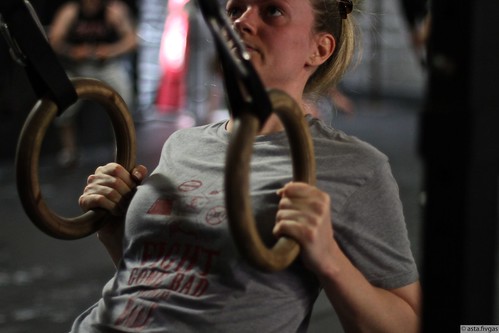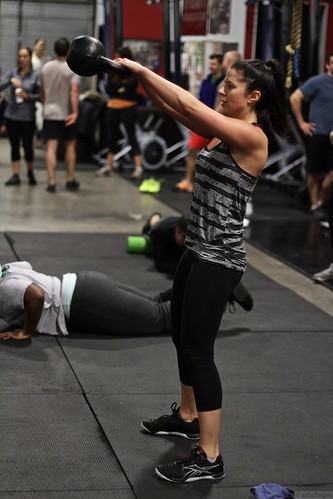
Back in July of 2011, CFSBK started noticing that while people were making good progress on their barbell lifts, we weren’t spending enough time developing basic gymnastics capacity through direct practice of foundational calisthenics. We noted that people could pull a lot of weight off the floor, but still struggled doing a set of 20 unbroken push-ups. To curb this trend, and in the spirit of the original 2003 "CrossFit Warm-Up," we implemented "Standardized Warm-Ups" (SWU) after intros and general movement prep. The intention was to dedicate eight to 10 minutes of class to training these movements while also performing an effective warm-up routine before the more rigorous training ahead. Before 2011, we usually wrote a novel warm-up for each class. We soon found that having a more consistent warm-up regime made running classes more efficient, and was a more effective training stimulus. Today we're going to talk about how CFSBK implemented SWU and provide some examples of templates we've used.
 Warm-Up Criteria
Warm-Up Criteria
For a warm-up to be effective, especially in the context of a CrossFit group class, it needs to meet the follow five key criteria, which we've listed below.
1. Effectively Warms Athletes Up
The most straightforward criteria is that the warm-up does exactly what it's supposed to: raise core temperature and prepare the soft tissue and joints for more intense training. By the time the warm-up is over, people should have a light sweat going and have moved through enough range-of-motion that their entire body feels limber and active. People often miss the mark on warm-ups by either making them too intense or under-programmed. The warm-up should not feel like a WOD, but it also shouldn’t be so easy that by the end of it you still feel stiff.
Remember that most people are coming to your gym after long days at the office or right out of bed and are going to need some time to get rolling. This is especially important for members in their 30's or higher, who tend require progressively more prep time. We also recommend generally avoiding ballistic movements like box jumps, sprints, etc. since cold tissue tends to be fragile tissue.
 2. Reinforces and Develops Basic Calisthenics (i.e., chin-ups, push-ups and lunges)
2. Reinforces and Develops Basic Calisthenics (i.e., chin-ups, push-ups and lunges)
As we mentioned above, a good warm-up also doubles as valuable training time. Programming strict chin-ups consistently into your warm-ups allows people repeated exposure to the movement at a rep range designed to either get them closer to their first unassisted rep, or increase capacity for those who already have the ability to perform them. For example, a beginner might be doing sets of five push-ups per round while a more advanced member might be doing 12 or so per round. Each person works at their own level and can adjust to make the exposures right for them. This is also a time to emphasize that practice makes permanent and athletes should strive to execute every rep with virtuosity. No matter how difficult or easy it may be, perfecting basic callisthenic movements will positively bleed into how athletes perform in metcons.
3. Balance of Joint Actions
The two SWUs that we offer at CFSBK (more on this below) are programmed with the intent of balancing basic joint actions. We want to make sure that we're generally doing both horizontal and vertical pulls and pushes as well as mixing up what kind of lower body action is being performed. This general balance helps ensure we're not overtraining a particular pattern, or ignoring another. Below are examples of how we might write two warm-ups considering a balance of movement planes:
Warm-Up 1
Dumbbell Push Press: vertical push
Ring Row: Horizontal pull
Walking Lunge: Contralateral lower body movement
Warm-Up 2
Push-Up: Horizontal Push
Chin-Up: Vertical Pull
Overhead Squat: Fixed lower body movement
We also sometimes program in global flexion movements like hollow rocks, hip extension movements like kettlebell swings and static holds. This doesn't need to be an exact science, but taking some time to think about how the warm-ups compliment each other goes a long way in creating balanced programming.
4. Does Not Interfere With the Day's Training
Along with not executing warm-ups with excessive intensity, athletes generally should not be doing 30 push-ups in a warm-up before doing "Cindy" 10 minutes later. If we're going to be performing the same exercise after the warm-up, CFSBK will either tell people to do the version without the overlapping movement or we offer a substitute. In the case of “Cindy,” we might substitute push-ups for kettlebell swings or hollow rocks. CFSBK likes to say that the warm-up is the "appetizer" and shouldn't get you full before the main course ahead.
5. Efficient to Run
Class time is valuable and we don't want to either have to explain the warm-up every single time we run it or deal with lots of questions about how to perform specific movements. By using simple exercises like ring rows or push-ups and offering consistent warm-up templates for fixed periods of time, people can get acclimated to them quickly and thus require minimal help setting up and executing. We want to be able to say "Okay guys, hit warm-up one or two, you've got eight minutes," and have almost everyone in class know exactly what to do and get to work within a few seconds. As mentioned in our article "using time stamps to manage classes" CFSBK also always uses a wall timer to let people know exactly how much time they've got to complete their work. We usually tell people to perform three rounds or simply work until the time cap, which is always either eight or 10 minutes.
Programming
As mentioned in our article "Effective Programming Strategies," CFSBK programs eight-week blocks that include some targeted adaptations. Those adaptations are intended to help achieve specific goals while maintaining our overarching goal of CrossFit-style GPP. At the beginning of each cycle, we write two new warm-ups that we'll use for all eight weeks. We announce them on the blog and post them for the duration of the cycle on the gym's programming white board so people see them every single day. Writing two versions is critical so that your most consistent members aren't doing the same thing every day. We instruct those members to simply alternate which one they do each time they come. For members who come one to two times per week, we might tell them to pick one version and do it every single time so that they can focus on fewer movements and make more progress. For example, if they want to get better at push-ups, they should always perform the warm-up with push-ups in it so they're practicing more times per week.
Examples
Here are some examples of SWUs. Give them a shot at your affiliate and see how it works for you! A 10 minute cap is plenty of time to go through three rounds, it can also be done in eight minutes but when we go that low we tell people to expect to get through two full rounds but possibly not the third.
Warm-Up 1
3 Rounds NFT of:
12 Overhead Squats (pvc or appropriate barbell)
5-10 Push-Ups
8 Ring Rows
Warm-Up 2
3 Rounds NFT of:
:20 Static or Rocking Hollow Hold
10e Reverse Lunges (optional to add a little load with DBs or Plate)
3-5 Pull-Ups or Chin-Ups with a :02 hold at the top
_________________
Warm-Up 1
3 Rounds NFT of:
16 Kettlebell Swings
4-8 CTB Chin-Ups
8-16 Push-Ups
Warm-Up 2
3 Rounds NFT of:
16 Dumbbell Thrusters
12 Ring Rows
200m Jog
_________________
Warm-Up 1
3 Rounds NFT of:
20 Kettlebell Swings (face level)
10 Overhead Walking Lunges (using bumper plates)
5 Pull-Ups
Warm-Up 2
3 Rounds NFT of:
Row 15 Calories
10-15 Push-ups
30 Hollow Rocks
_________________
In a future article, we'll talk about some other ways CFSBK has "hacked" standardized warm-ups by using tempos, leveled programming, and staggering athletes. How do you warm your athletes up?